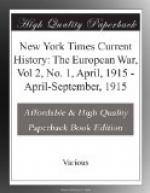The Germans, being neither mad nor misinformed, why they face a world of foes with this new confidence becomes a question of importance to any one who wants to understand the real situation here. The answer is Hindenburg—not only the man himself, but all that he stands for, the personification of the German war spirit, the greatest moral asset of the empire today. He is idolized not only by the soldiers, but by the populace as well; not only by the Prussians, but by the Bavarians and even the Austrians. You cannot realize what a tremendous factor he has become until you discover personally the Carlylean hero worship of which he is the object.
Hindenburg woke up one morning to find himself famous; but his subsequent speedy apotheosis was probably not entirely spontaneous. In fact, there is reason to believe that he was carefully groomed for the role of a national hero at a critical time, the process being like the launching by American politicians of a Presidential or Gubernatorial boom at a time when a name to conjure with is badly needed. He is a striking answer to the Shakespearean question. His name alone is worth many army corps for its psychological effect on the people; it has a peculiarly heroic ring to the German ear, and part of the explanation of its magic lies probably in the fact that the last syllable, “burg,” means fortress or castle. He inspires the most unbounded confidence in the German people; the Field Marshal looms larger than his Kaiser.
The cigarmakers were the first to recognize his claims to immortality and to confer it on him; but now almost every conceivable sort of merchandise except corsets is being trade marked Hindenburg. Babies, fishing boats, race horses, cafes, avenues and squares, a city of 60,000, a whole county, are being named after him, and minor poets are taking his name in vain daily, “Hindenburg Marches” are being composed in endless procession, a younger brother is about to publish his biography, and legends are already thickly clustering about his name. He laid the Russian bugaboo before it had a chance to make its debut; there is not today the slightest nervousness about the possible coming of the Cossacks, and there will not be, so long as the Commander in Chief of all the armies in the east continues to find time to give sittings to portrait painters, pose for the moving-picture artists, autograph photographs, appear on balconies while school children sing patriotic airs, answer the Kaiser’s telegrams of congratulation, acknowledge decorations, receive interminable delegations, personages, and journalists, and perform all the other time-consuming duties incident to having greatness thrust upon you; for things obviously cannot be in a very bad way when the master strategist can thus take “time out” from strategizing. But the influence of “our Hindenburg,” as he is often affectionately called, is wider than the east; the magic of his name stiffens the deadline in the west, and the man in the street, whose faith is great, feels sure that when he has fought his last great battle in the east the turn of the French and English will come.




